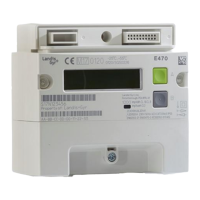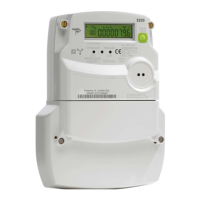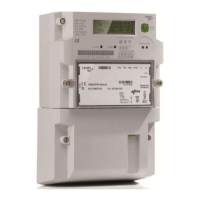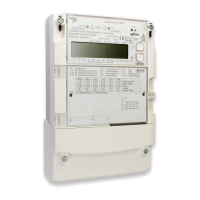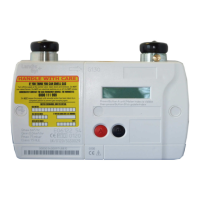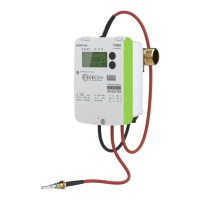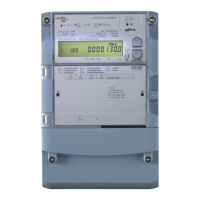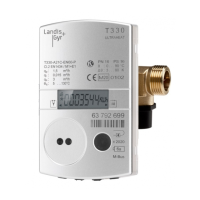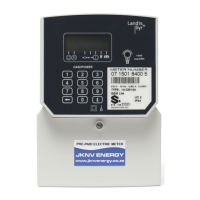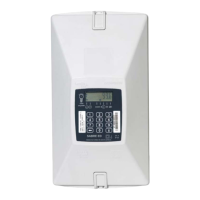Do you have a question about the Landis+Gyr E470 and is the answer not in the manual?
Manual's scope and applicability.
Manual's purpose and content overview.
Intended audience for the user manual.
Meter's intended application and installation guidelines.
Defines responsibilities for meter work.
Detailed description of the E470 meter's components.
Explains the meter's measurement and data processing functions.
Specifies operating and storage temperature ranges.
Details the meter's real-time clock and DST settings.
Describes the meter's display and button layout.
Explains the features of the meter's customer display.
Details the meter's energy registers and their display.
Explains how to operate the meter using its push buttons.
Describes the process of entering payment codes.
Explains the audible alerts provided by the meter's buzzer.
Covers anti-tamper features like reverse energy and SIM card detection.
Details the meter's detection of reverse energy flow.
Explains the meter's response to SIM card tampering.
Describes the procedure for hot-swapping the SIM card.
Outlines the different operational modes like Credit, Prepayment, Single Wallet.
Explains the meter's load limiting functionality.
Describes the process of joining devices to the electricity meter.
Details the code entry procedure for installation and binding.
Explains the process of decommissioning and disposing of the meter.
Details the procedure for meter exchange.
Outlines the procedure for removing the meter.
Describes how to request immediate meter readings.
Explains handling tenancy or supplier changes.
Details the process for restoring electricity supply.
Explains the meter's profiling capabilities.
Describes automatic scheduled meter reading transmissions.
Explains the operation of Time-Of-Use tariffs.
Details the TOU rate switching scheme.
Provides an example of a seasonal weekday/weekend tariff.
Describes configuration for special days.
Explains the structure and application of block tariffs.
Defines billing periods for block tariffs.
Explains how tariff prices are compiled.
Illustrates TOU, Block, and Combination tariff examples.
Details how the standing charge is handled.
Describes setting future tariff activation dates.
Explains block tariffs applied on a daily basis.
Details the meter's capability to handle CCL and VAT.
Explains the meter's operation in credit mode.
Describes the continuously updated credit/debt balance.
Details the log of the last 20 payments received.
Records total purchased credit since commissioning.
Provides budgeting info like cost per hour/day.
Allows preventing disconnection during specific times.
Explains the role of magnetic cards for identification.
Details the facility providing credit when balance is low.
Explains how standing charges are deducted.
Describes the process of recovering preset debt.
Details the process of converting currency.
Overview of configurable display items.
Describes display icons for currency and signal strength.
Shows the current credit or debt status.
Indicates when Emergency Credit is available.
Shows Emergency Credit status and debt to clear.
Displays the active rate and register number.
Options for cycling through display items.
Shows the current time in HH:MM format.
Displays TOU energy registers.
Displays the energy cost per kWh.
Shows the last three payments with value and date.
Displays weekly standing charge.
Displays weekly debt recovery amount.
Shows the total outstanding debt.
Shows the configured Emergency Credit value.
Indicates when Emergency Credit becomes available.
Displays RED or OPEN messages for tamper events.
Shows energy measured in reverse.
Describes the process for entering various codes.
Covers the initial installation process.
Details the entry of MPAN or Customer number.
Describes entering previous meter balance.
Details entering arrears from a previous meter.
Describes the entry of the installer's authorisation code.
Points to observe during scheduled meter visits.
Describes periodic meter testing procedures.
Explains how to amend factory configured options.
Guides troubleshooting for common operating faults.
Details the procedure for safely disconnecting the meter.
Outlines the process for meter repair.
Lists and defines common acronyms used in the manual.
Lists and defines measurement units used.
Manual's scope and applicability.
Manual's purpose and content overview.
Intended audience for the user manual.
Meter's intended application and installation guidelines.
Defines responsibilities for meter work.
Detailed description of the E470 meter's components.
Explains the meter's measurement and data processing functions.
Specifies operating and storage temperature ranges.
Details the meter's real-time clock and DST settings.
Describes the meter's display and button layout.
Explains the features of the meter's customer display.
Details the meter's energy registers and their display.
Explains how to operate the meter using its push buttons.
Describes the process of entering payment codes.
Explains the audible alerts provided by the meter's buzzer.
Covers anti-tamper features like reverse energy and SIM card detection.
Details the meter's detection of reverse energy flow.
Explains the meter's response to SIM card tampering.
Describes the procedure for hot-swapping the SIM card.
Outlines the different operational modes like Credit, Prepayment, Single Wallet.
Explains the meter's load limiting functionality.
Describes the process of joining devices to the electricity meter.
Details the code entry procedure for installation and binding.
Explains the process of decommissioning and disposing of the meter.
Details the procedure for meter exchange.
Outlines the procedure for removing the meter.
Describes how to request immediate meter readings.
Explains handling tenancy or supplier changes.
Details the process for restoring electricity supply.
Explains the meter's profiling capabilities.
Describes automatic scheduled meter reading transmissions.
Explains the operation of Time-Of-Use tariffs.
Details the TOU rate switching scheme.
Provides an example of a seasonal weekday/weekend tariff.
Describes configuration for special days.
Explains the structure and application of block tariffs.
Defines billing periods for block tariffs.
Explains how tariff prices are compiled.
Illustrates TOU, Block, and Combination tariff examples.
Details how the standing charge is handled.
Describes setting future tariff activation dates.
Explains block tariffs applied on a daily basis.
Details the meter's capability to handle CCL and VAT.
Explains the meter's operation in credit mode.
Describes the continuously updated credit/debt balance.
Details the log of the last 20 payments received.
Records total purchased credit since commissioning.
Provides budgeting info like cost per hour/day.
Allows preventing disconnection during specific times.
Explains the role of magnetic cards for identification.
Details the facility providing credit when balance is low.
Explains how standing charges are deducted.
Describes the process of recovering preset debt.
Details the process of converting currency.
Overview of configurable display items.
Describes display icons for currency and signal strength.
Shows the current credit or debt status.
Indicates when Emergency Credit is available.
Shows Emergency Credit status and debt to clear.
Displays the active rate and register number.
Options for cycling through display items.
Shows the current time in HH:MM format.
Displays TOU energy registers.
Displays the energy cost per kWh.
Shows the last three payments with value and date.
Displays weekly standing charge.
Displays weekly debt recovery amount.
Shows the total outstanding debt.
Shows the configured Emergency Credit value.
Indicates when Emergency Credit becomes available.
Displays RED or OPEN messages for tamper events.
Shows energy measured in reverse.
Describes the process for entering various codes.
Covers the initial installation process.
Details the entry of MPAN or Customer number.
Describes entering previous meter balance.
Details entering arrears from a previous meter.
Describes the entry of the installer's authorisation code.
Points to observe during scheduled meter visits.
Describes periodic meter testing procedures.
Explains how to amend factory configured options.
Guides troubleshooting for common operating faults.
Details the procedure for safely disconnecting the meter.
Outlines the process for meter repair.
Lists and defines common acronyms used in the manual.
Lists and defines measurement units used.
| Brand | Landis+Gyr |
|---|---|
| Model | E470 |
| Category | Measuring Instruments |
| Language | English |
